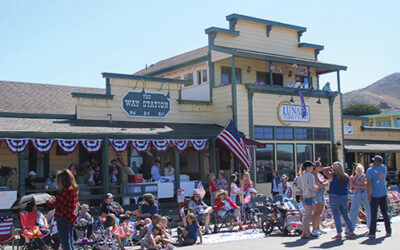With Old Man Winter upon us, and El Niño brewing in the Pacific, the City of Morro Bay has issued a checklist for residents and property owners to help them prepare for potential big storms and all the misery it can bring.
The City said the National Oceanic and Atmospheric Administration or NOAA predicts a 95% chance of an El Niño this winter and 66% chance of a strong El Niño.
El Niño is the name of a warm water current that comes up the West Coast bringing strong, very-wet storms here, as happened last winter.
El Niño winters have in the past brought well over 30-inches of rain to Morro Bay, about double the normal rainfall of about 16-inches a year.
(On the other hand, a “La Niña,” or colder water current, tends to bring dry winters our way.)
“Past strong El Niños,” the City warned, “have been characterized by extended periods of high intensity rainfall, triggering heavy runoff, floods, mudslides, debris flow, and landslides both inland and along the coast.”
The Checklist Includes:
• Inspect slopes: Visually inspect all sloped areas for signs of erosion gullying, surface cracks, and slumping. Inspect buildings, patios, retaining walls, and garden walls for signs of cracking or rotation, which may indicate slope movement has occurred. If signs of slope movement are observed, consider contacting a California-licensed geologist or geotechnical engineer for a site inspection.
• Inspect bare ground: Large bare areas may be sources for mudflows during rain. Consider covering or vegetating bare areas before storm season. Consider covering and securing mounds of loose soil or fill material.
• Inspect drains and gutters: Visually inspect and remove debris from retaining wall drains, surface drains, culverts, and gutters before storm season. Storm water runoff should be directed into appropriate drainage control areas to avoid excessive soil saturation.
• Inspect structures: Visually inspect all structures for signs of distress, loss of material, obstructed drainage, or exposed reinforcing steel before storm season and after every rainstorm. If significant problems are observed, consider contacting a California-licensed engineer for maintenance suggestions.
• Inspect Roofs: Visually inspect roofs, or hire a roofing contractor, to check for loose tiles, holes or other signs of distress.
The City has also dropped a large pile of sand at the City/County Library parking lot on Shasta Avenue for residents to fill sandbags, but you’ll have to bring a shovel and your own bags, which are usually available at hardware stores.
And remember, the time to fill sandbags is before the big storms hits.
The City also has a message for everyone to heed:
“The public is also encouraged to prepare for severe weather and other natural disasters by ensuring they have taken steps for personal emergency preparedness.
“The recommendation is to have sufficient supplies in your residence to sustain each occupant for at least 72 hours.
“This includes food, water, medications, clothing, batteries, flashlights, sanitation supplies, blankets or bedding for warmth, and sources for backup power such as battery packs, generators, etc. to charge cell phones and radios.”
Just as with wildfires, you should pre-pack a “go bag” with the essentials listed here and be ready to go at a moment’s notice should emergency personnel call for an evacuation.



